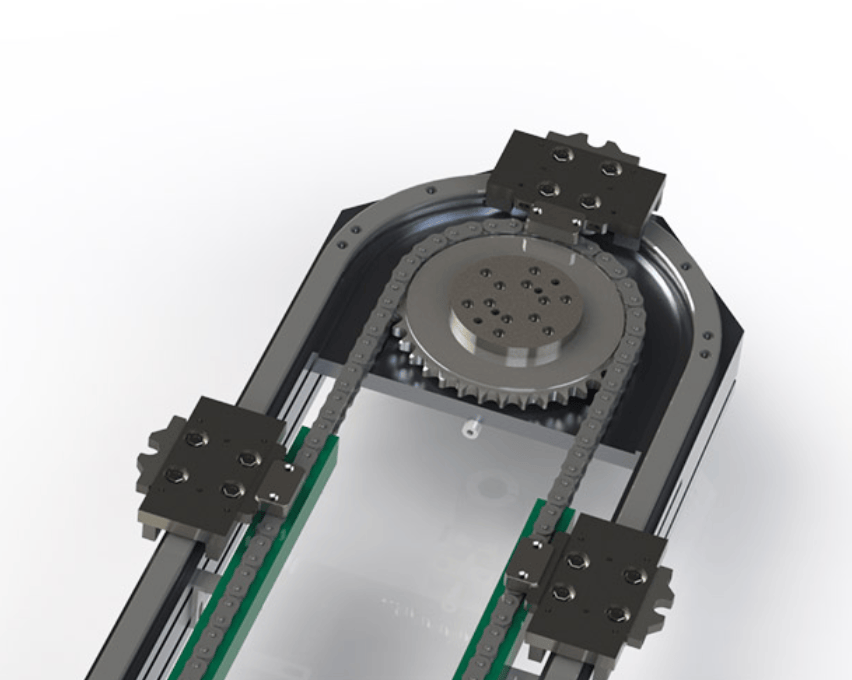At 3:00 am, a lithium battery factory production line suddenly stopped - quality control supervisor at the end of the conveyor line found that the surface of the pole piece attached to the metal debris, the entire batch of 800,000 yuan worth of cores were forced to scrap. This is not a coincidence.Dust pollution in the lithium battery transport chain is becoming a hidden killer that eats up the yield rate.. This article is based on the head of the battery enterprise combat experience, dismantling the conveyor line dust control of the 3 core skills, to help you reduce dust pollution caused by the scrapping rate of more than 80%.
I. The deadly chain of transmission of dust hazards
When the battery pole piece on the conveyor belt is contaminated with 0.1mm metal dust:
- self-discharge accelerationDust punctures diaphragm and causes micro-short circuit, with voltage degradation exceeding 5% within 48 hours.
- runaway security: The temperature at the dust gathering point during the charging and discharging process rises by 120°C, inducing thermal runaway.
- process paralysis: Winding machine shutdown due to dust jam, single failure costs over $150,000
Data of a Top3 Battery Factory: Uncontrolled dust production line monthly due to dust pollution scrapped 27,000 pieces of battery cells, annual losses of more than 20 million yuan
Second, dust control 3 major practical skills
▶ Tip 1: Source Interception - Conveyor System Confinement Modification
Scenario pain points: Open conveyor belt for aluminium chips in the winding process, with an adhesion rate of up to 12 chips/m².
prescription::
- Sandwich seal construction::
- Upper layer: 5mm thick acrylic transparent cover (light transmittance 92%)
- Middle level: negative pressure dust removal duct (wind speed ≥ 25m/s)
- Bottom layer: Conductive TPU conveyor belt (surface resistance 10⁶Ω)
- Modular quick release design: Maintenance time compressed from 45 minutes to 8 minutes
Effectiveness of implementationDust density on the surface of electrodes was reduced from 158 particles/cm² to 9 particles/cm² after modification in one enterprise.
▶ Tip 2: Dynamic Capture - Electrostatic Discharge + Directional Adsorption
Scenario pain pointsPolymer dust is electrostatically attracted to the pole piece, which makes conventional hoovers ineffective.
crack programme::
Image Codegraph LR A[Ionising air rods to remove static electricity] --> B(Dust off pole piece) B --> C[Vortex adsorption device capture] C --> D {Nano-fibre cartridge filtration}#svgGraph04403576193611{font-family: "trebuchet ms",verdana,arial,sans-serif;font-size:16px;fill:#333;}@keyframes edge- animation-frame{from{stroke-dashoffset:0;}}@keyframes dash{to{stroke-dashoffset:0;}}#svgGraph04403576193611 .edge-animation-slow {stroke-dasharray:9,5!important;stroke-dashoffset:900;animation:dash 50s linear infinite;stroke-linecap:round;} #svgGraph04403576193611 .edge-animation-fast{stroke-dasharray:9,5!important;stroke-dashoffset:900;animation:dash 20s linear infinite;stroke-linecap:round;}#svgGraph04403576193611 .error-icon{fill:#552222;}#svgGraph04403576193611 .error-text{ fill:#552222;stroke:#552222;}#svgGraph04403576193611 .edge-thickness-normal{stroke-width:1px;} #svgGraph04403576193611 .edge-thickness-thick{stroke-width:3.5px;}#svgGraph04403576193611 .edge-pattern-solid{stroke- dasharray:0;}#svgGraph04403576193611 .edge-thickness-invisible{stroke-width:0;fill:none;}#svgGraph04403576193611 .edge- pattern-dashed{stroke-dasharray:3;}#svgGraph04403576193611 .edge-pattern-dotted{stroke-dasharray:2;}#svgGraph04403576193611 .marker{fill:#333333;stroke:#333333;}#svgGraph04403576193611 .marker.cross{stroke:#333333;} #svgGraph04403576193611 svg{font-family: "trebuchet ms",verdana,arial,sans-serif;font-size:16px;}#svgGraph04403576193611 p{ margin:0;}#svgGraph04403576193611 .label{font-family: "trebuchet ms",verdana,arial,sans-serif;color:#333;} #svgGraph04403576193611 .cluster-label text{fill:#333;}#svgGraph04403576193611 .cluster-label span{color:#333;} #svgGraph04403576193611 .cluster-label span p{background-colour:transparent;}#svgGraph04403576193611 .label text, #svgGraph04403576193611 span{fill:#333;color:#333;}#svgGraph04403576193611 .node rect,#svgGraph04403576193611 . node circle,#svgGraph04403576193611 .node ellipse,#svgGraph04403576193611 .node polygon,#svgGraph04403576193611 .node path{ fill:#ECECFF;stroke:#9370DB;stroke-width:1px;}#svgGraph04403576193611 .rough-node .label text,#svgGraph04403576193611 .node .label text,#svgGraph04403576193611 .image-shape .label,#svgGraph04403576193611 .icon-shape .label{text-anchor:middle;} #svgGraph04403576193611 .node .katex path{fill:#000;stroke:#000;stroke-width:1px;}#svgGraph04403576193611 .rough-node . label,#svgGraph04403576193611 .node .label,#svgGraph04403576193611 .image-shape .label,#svgGraph04403576193611 .icon-shape . label{text-align:centre;}#svgGraph04403576193611 .node.clickable{cursor:pointer;}#svgGraph04403576193611 .root .anchor path{ fill:#333333!important;stroke-width:0;stroke:#333333;}#svgGraph04403576193611 .arrowheadPath{fill:#333333;} #svgGraph04403576193611 .edgePath .path{stroke:#333333;stroke-width:2.0px;}#svgGraph04403576193611 .flowchart-link{stroke :#333333;fill:none;}#svgGraph04403576193611 .edgeLabel{background-color:rgba(232,232,232, 0.8);text-align:centre;} #svgGraph04403576193611 .edgeLabel p{background-color:rgba(232,232,232, 0.8);}#svgGraph04403576193611 .edgeLabel rect{opacity. 0.5;background-color:rgba(232,232,232, 0.8);fill:rgba(232,232,232, 0.8);}#svgGraph04403576193611 .labelBkg{background-color:rgba( 232, 232, 232, 0.5);}#svgGraph04403576193611 .cluster rect{fill:#ffffde;stroke:#aaaa33;stroke-width:1px;} #svgGraph04403576193611 .cluster text{fill:#333;}#svgGraph04403576193611 .cluster span{color:#333;} #svgGraph04403576193611 div.mermaidTooltip{position:absolute;text-align:centre;max-width:200px;padding:2px;font-family:" trebuchet ms",verdana,arial,sans-serif;font-size:12px;background:hsl(80, 100%, 96.2745098039%);border:1px solid #aaaa33; border-radius:2px;pointer-events:none;z-index:100;}#svgGraph04403576193611 .flowchartTitleText{text-anchor:middle;font-size: 18px;fill:#333;}#svgGraph04403576193611 rect.text{fill:none;stroke-width:0;}#svgGraph04403576193611 .icon-shape, #svgGraph04403576193611 .image-shape{background-color:rgba(232,232,232, 0.8);text-align:centre;}#svgGraph04403576193611 .icon -shape p,#svgGraph04403576193611 .image-shape p{background-color:rgba(232,232,232, 0.8);padding:2px;}#svgGraph04403576193611 . icon-shape rect,#svgGraph04403576193611 .image-shape rect{opacity:0.5;background-color:rgba(232,232,232, 0.8);fill:rgba(232,232, 232, 0.8);}#svgGraph04403576193611 :root{-mermaid-font-family: "trebuchet ms",verdana,arial,sans-serif;}
Ion wind rod de-static
Dust off the pole piece
Vortex adsorption device capture
Nanofibre cartridge filtration
- Ion wind rods deployment spacing: Groups every 1.5 metres (voltage 7.5kV)
- Eddy current adsorption efficiency: 99.2% for 0.3μm particles.
- Filter Material Upgrade: Adoption of PTFE-coated cartridges (filtration accuracy 0.1μm)
case (law): After the application of stacking conveyor line in a plant of Ningde Times, the damage rate of pole pieces caused by dust decreased by 85%
▶ Tip 3: Intelligent prevention and control - IoT real-time monitoring
Scenario pain points: Intermittent dust outbreaks undetectable by traditional spot checks
technological breakthrough::
- Sensor Matrix::
- Laser particle counters (0.3-10 μm graded monitoring)
- Static Induction Metal Detectors
- Intelligent Early Warning System::
- Dust concentration over the threshold automatic speed reduction conveyor line
- Linkage dust removal equipment power increase 30%
Data Kanban for an enterprise::
| parameters | pre-conversion | after conversion |
|---|---|---|
| Dust Peak Response | 45 minutes | 8 seconds. |
| abnormal stoppage | 12 times/month | 0th |
| error rate | 23% | 1.7% |
III. Compound Benefits of Yield Improvement
-
Direct quality gains
- Self-discharge defective rate reduced from 1.8% to 0.3%
- Winding process straight through rate increase 14%
-
Hidden cost savings
- Reduction in cleaning labour hours by 70% (formerly 4 persons per day x 2 hours)
- Reduced frequency of equipment maintenance 60%
-
Security Redundancy Enhancement
- Thermal runaway incident rate down to 0.02 incidents/million cells
Industry Benchmarking PracticesLithium Ion's annual quality cost savings of 34 million RMB and ROI of 8.7 times through dust control modification of conveying lines.
IV. Direction of technological evolution
- Self-cleaning conveyor belts: Bionic dust-removal coating (contact angle > 150°)
- Dust Resourcing: Lithium cobalt oxide dust recovery rate exceeds 95%
- digital twin defence and control: AI Predicts Dust Aggregation Paths with Accuracy 92%
"Dust control is not just a cleanliness issue, it's a lifeline to battery safety. When the dust particles on the conveyor line go to zero, the yield curve will really go up steeply." --Interview with CTO of a new energy enterprise
List of actions::
- Baseline testing of conveyor line dust concentrations completed this week
- Priority implementation of static dissipative device retrofitting next month
- Quarterly Budget Planning Intelligent Monitoring System Deployment
Victory in the dust wars belongs not to the perfect solution, but to the wise man who takes the lead. When your conveyor belts start breathing clean air, the spring of good yield has arrived.













